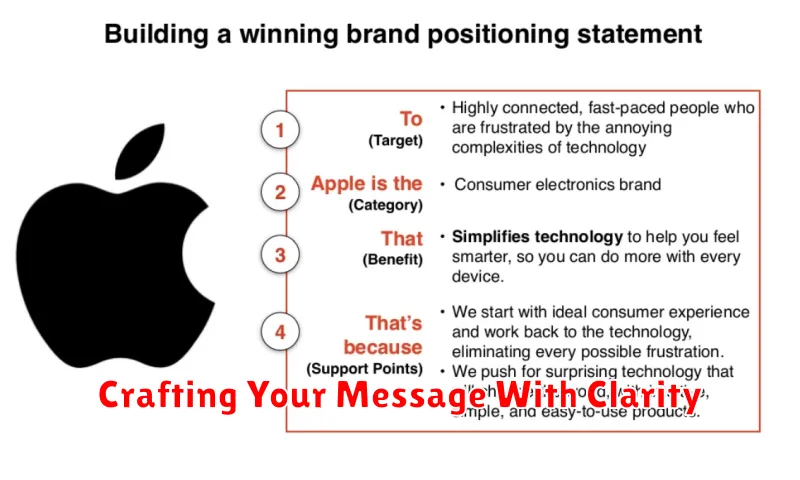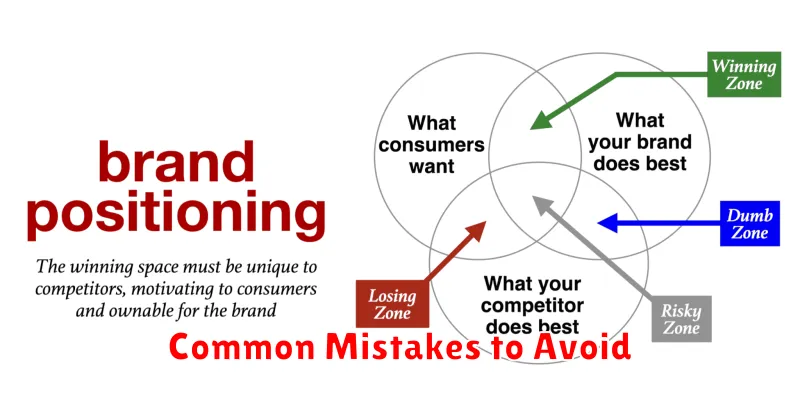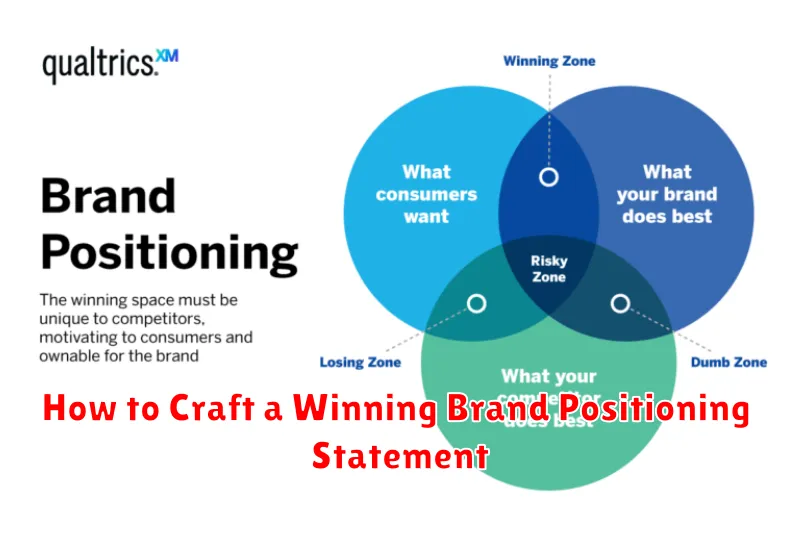Crafting a winning brand positioning statement is crucial for any business seeking to establish a strong market presence. A well-defined brand positioning statement serves as the foundation for all marketing efforts, ensuring consistent messaging and a clear understanding of your brand’s unique value proposition. This guide will delve into the essential steps to create a brand positioning statement that resonates with your target audience, differentiates you from competitors, and ultimately drives business growth. Understanding how to craft a compelling brand positioning statement is the key to unlocking your brand’s full potential and achieving lasting success.
Developing a strong brand positioning statement requires careful consideration of your target market, competitive landscape, and core brand values. By defining what makes your brand unique and valuable, you can effectively communicate this message to your audience and build a loyal customer base. This article will provide a practical framework for creating a concise and impactful brand positioning statement, covering key elements such as identifying your target audience, defining your unique selling proposition, and crafting a memorable and persuasive message. Learn how to create a winning brand positioning statement that sets your brand apart and drives measurable results.
What Is a Brand Positioning Statement?
A brand positioning statement is a concise, internal document that articulates a brand’s unique value proposition to its target audience. It serves as a guiding principle for all marketing and communication efforts, ensuring consistent messaging and a clear understanding of the brand’s identity. A strong positioning statement defines the target market, the key benefit the brand offers, the category or frame of reference, and the primary reason to believe the brand’s promise.
This statement is different from a tagline or slogan, which are external marketing messages. The positioning statement provides the foundation for those outward-facing messages. It helps clarify the brand’s competitive advantage and explains why consumers should choose that brand over others. Essentially, it answers the crucial question: “Why should someone buy from us?”
Developing a strong brand positioning statement requires a thorough understanding of the target audience, competitive landscape, and the brand’s own strengths and weaknesses. It should be memorable, easily understood, and actionable for everyone within the organization. By clearly articulating the brand’s position in the market, the positioning statement enables effective marketing strategies that resonate with consumers and drive business growth.
Why Positioning Matters for Market Clarity
Positioning is crucial for establishing a clear and distinct place for your product or service in the minds of consumers. It’s about defining how your offering uniquely addresses a specific need or solves a particular problem better than the competition. Effective positioning clarifies your value proposition, making it easier for target customers to understand what you offer and why they should choose you.
Without a strong position, your brand risks getting lost in the noise of a crowded marketplace. Customers may struggle to differentiate you from competitors, leading to confusion and ultimately, lost sales. A well-defined position acts as a guide for all marketing efforts, ensuring consistent messaging and a focused approach to reaching the right audience. This clarity resonates not only with potential customers but also with internal teams, providing a unified understanding of the brand’s purpose and direction.
A compelling position ultimately drives market success. It simplifies the customer’s decision-making process, builds brand loyalty, and allows for premium pricing. By clearly articulating your value and differentiation, you establish a sustainable competitive advantage and a stronger connection with your target market.
Essential Components of a Positioning Statement
A positioning statement is a concise, compelling summary that defines a product or brand’s unique value proposition within the target market. It serves as an internal guide for marketing and communication efforts, ensuring consistency and clarity across all channels. A strong positioning statement typically includes three key elements: the target audience, the category or frame of reference in which the brand competes, and the key benefit or point of differentiation.
Defining the target audience is crucial for effective positioning. This involves identifying specific demographic, psychographic, and behavioral characteristics of the intended consumer. Clearly articulating this target helps tailor messaging and resonate with the desired audience. Next, specifying the category or frame of reference establishes the context within which the brand operates. This positions the product or service against competitors and clarifies what needs it fulfills. Finally, highlighting the key benefit or point of differentiation distinguishes the brand from competitors. This unique value proposition should clearly address what makes the product or service superior and why customers should choose it.
A well-crafted positioning statement should be memorable, easily understood, and focused on a single, compelling idea. It should also be actionable, providing a clear direction for marketing activities and informing decision-making across the organization. By effectively addressing these key components, a positioning statement provides a solid foundation for building a strong brand identity and communicating value to the target market.
Identifying Your Unique Selling Proposition
A Unique Selling Proposition (USP) is a statement that clearly articulates the distinct benefits your product or service offers compared to the competition. It highlights what makes your offering special and why customers should choose you over alternatives. A strong USP is essential for effective marketing, branding, and overall business success. It focuses on the value you provide to your target audience and addresses their specific needs or pain points.
Identifying your USP requires careful consideration of several factors. You must understand your target market and their specific requirements. Thoroughly analyze your competitors to identify gaps and opportunities in the market. Finally, honestly assess your own strengths and weaknesses to determine what truly sets you apart. This could be superior quality, innovative features, exceptional customer service, competitive pricing, or a niche specialization.
Once you have identified your USP, effectively communicating it is crucial. Use concise and compelling language to clearly convey the value proposition to your target audience. Ensure your USP is consistently reflected in your marketing materials, website content, and overall brand messaging. A well-defined and effectively communicated USP can significantly differentiate your business in a crowded marketplace, attract customers, and drive growth.
Crafting Your Message With Clarity

Clarity is paramount in effective communication. A clear message ensures your audience understands your intent without confusion, saving time and preventing misinterpretations. Focus on using precise language and structuring your thoughts logically. Avoid jargon or overly complex sentence structures that could obscure your meaning.
Conciseness is equally important. Get straight to the point and eliminate unnecessary words or phrases. A shorter message is more likely to be read and retained by your audience. Prioritize the most crucial information and present it in a direct and impactful manner.
Finally, consider the context of your message. Who is your audience? What is the purpose of your communication? Tailoring your message to the specific context ensures its relevance and effectiveness. By being mindful of these factors, you can craft a message that is clear, concise, and impactful.
Positioning vs Taglines vs Mission
Positioning, taglines, and mission statements are distinct yet interconnected elements of a brand’s identity. Positioning describes how a brand occupies a unique space in the customer’s mind relative to competitors. It focuses on the target audience’s perception and answers the question, “Why should a customer choose this brand over others?” A strong positioning statement considers the brand’s strengths, the competitive landscape, and the needs and desires of the target market. It serves as the foundation for all other marketing efforts.
A tagline is a short, memorable phrase that captures the essence of the brand’s positioning and value proposition. It’s a concise and impactful way to communicate the key benefit or differentiation point to the target audience. Think of taglines like Nike’s “Just Do It” or Apple’s “Think Different.” They’re easily recognizable and reinforce the brand’s message in a memorable way.
A mission statement defines a company’s overall purpose and long-term goals. It explains why the company exists and what it hopes to achieve. While related to positioning and taglines, a mission statement is broader in scope and internally focused, guiding the company’s decisions and actions. It communicates the company’s values and aspirations to stakeholders, including employees, investors, and customers.
Aligning Positioning With Brand Voice
Brand positioning and brand voice are two vital elements of a successful brand strategy. Positioning defines where your brand stands in the market relative to competitors, focusing on what makes you unique and desirable to your target audience. Brand voice, on the other hand, is the personality and tone expressed through all your communications, shaping how your audience perceives your brand’s character. Aligning these two ensures that your message resonates with your intended audience and reinforces your desired brand image.
When positioning and voice are misaligned, it creates confusion and dilutes your brand’s impact. Imagine a brand positioned as a premium, luxury provider using a casual, slang-filled voice. This disconnect undermines the intended message and can alienate the target customer. Conversely, a brand targeting a younger, trendier audience with a stiff, formal voice will likely struggle to connect authentically. Aligning these elements ensures a consistent and compelling brand experience across all touchpoints.
To effectively align positioning and voice, clearly define both. Understand your target audience’s values and preferences, and articulate your brand’s unique value proposition. Then, develop a voice that reflects these elements, ensuring it’s consistent across all platforms, from website copy to social media posts. This alignment creates a cohesive brand identity that strengthens customer connection and drives business success.
Testing Your Positioning With Target Audiences
Testing your positioning is crucial for ensuring your message resonates with your target audience. It helps validate your assumptions about their needs, preferences, and perceptions of your brand. Effective testing involves presenting your positioning statement and key messages to representative segments of your target audience and gathering feedback. This feedback should inform refinements to your positioning to optimize its impact and effectiveness.
Several methods can be used for testing, including surveys, focus groups, and A/B testing of marketing materials. Surveys allow for quantitative data collection on a larger scale, while focus groups offer qualitative insights into audience perceptions and reactions. A/B testing provides real-world data on how different versions of your positioning perform in actual market conditions. Choosing the right method depends on your specific needs and resources.
By carefully testing your positioning, you can minimize the risk of miscommunication and maximize the chances of successfully connecting with your target audience. A strong, well-tested position sets the foundation for all marketing efforts and helps ensure consistent brand messaging across all channels. It also allows you to differentiate your brand effectively within the competitive landscape and build a strong brand identity.
Examples of Strong Brand Positioning
Apple has consistently positioned itself as a premium brand, emphasizing design, innovation, and user experience. They cultivate a sense of community and belonging among their users, fostering strong brand loyalty. Their marketing materials and product design consistently reinforce this message of effortless simplicity and high quality.
Volvo has long been synonymous with safety. This core value has been the cornerstone of their brand positioning for decades, driving their product development and marketing campaigns. Consumers associate Volvo with reliability and security, making it a top choice for families and safety-conscious individuals.
Nike embodies athletic performance and inspiration. Their “Just Do It” slogan encapsulates their brand message, encouraging everyone to push their limits and achieve their athletic goals. They partner with top athletes and leverage powerful storytelling to connect with their target audience on an emotional level.
Common Mistakes to Avoid

One of the most common mistakes people make is failing to plan ahead. Whether it’s a project, a trip, or even just a simple task, taking the time to properly prepare can save you a lot of trouble down the road. This involves outlining your goals, anticipating potential challenges, and gathering the necessary resources. By being proactive and thinking ahead, you can avoid unnecessary stress and increase your chances of success.
Another frequent error is neglecting to communicate effectively. Misunderstandings and misinterpretations can easily arise when communication is unclear or insufficient. This is particularly important in team settings or when working with clients. Be sure to articulate your thoughts and ideas clearly, actively listen to others, and ask questions to ensure everyone is on the same page. Clear communication fosters collaboration and helps prevent costly errors.
Finally, many people underestimate the importance of attention to detail. Small oversights can sometimes have significant consequences, especially in areas like data entry, proofreading, or technical work. Developing a keen eye for detail and establishing systems for double-checking your work can help you catch mistakes before they become major problems. This careful approach promotes accuracy and professionalism.

